Cold City Cash for Edwards Brothers Land?
Ann Arbor city council meeting (Jan. 6, 2014): On a bitter cold night, Ann Arbor city councilmembers ended their first regular meeting of the year with an item not originally on their agenda. They passed a resolution that directs city administrator Steve Powers and city attorney Stephen Postema to gather information to help the city council determine whether to purchase the 16.7-acre Edwards Brothers Malloy property on South State Street.

Graph from weatherspark.com showing the -12 F temperature at the start of the Jan. 6, 2014 city council meeting. (Image links to weatherspark.com)
The direction came after the city council met in a closed session for about half an hour. Councilmembers emerged to craft and then pass the resolution. It gives direction to explore options to make the purchase financially feasible. That means finding a way to finance a $12.8 million deal. The sale of the Edwards Brothers property on South State Street is currently pending to the University of Michigan for $12.8 million, in an agreement that was announced in a Nov. 27, 2013 press release. The business – a fourth-generation Ann Arbor publishing and printing firm – had signaled its intent to put the property on the market in late July.
The topic of the possible land acquisition ties in to an upcoming Jan. 13 city council work session about economic development.
At the start of the Jan. 6 meeting, the council got an update from three key staff members about the city’s response to the snowstorm that had hit the entire Midwest over the weekend.
From public services area administrator Craig Hupy they heard an update on snowplowing, which was continuing during the meeting. From police chief John Seto, they heard an update on the police department’s support for relocating residents of a housing complex after a water pipe burst. And from Mary Jo Callan, Washtenaw County’s director of the office of community and economic development, they heard an update on efforts to address the needs of the homeless population during the freezing weather.
Concern for how the homeless were faring was the topic of eight out of nine speakers who signed up for public commentary reserved time.
In its regular business agenda, the council dispatched two items leftover from its last meeting of 2013. One of those items was the official termination of a four-year-old memorandum of understanding with the University of Michigan for construction of the Fuller Road Station project. That item was voted through with little controversy, although mayor John Hieftje compared it to digging someone up who died a couple of years ago and re-burying them.
Fuller Road Station was a planned joint city/University of Michigan parking structure, bus depot and possible train station located at the city’s Fuller Park near the UM medical campus. The council had approved the MOU on Fuller Road Station at its Nov. 5, 2009 meeting on a unanimous vote. However, a withdrawal of UM from the project, which took place under terms of the MOU, was announced on Feb. 10, 2012.
The other item delayed from last year was a resolution assigning a specific cost to the removal of on-street metered parking spaces, in connection with future developments: $45,000 per space. That amount was based on the cost of constructing a new parking space in a structure. After the policy was amended during the Jan. 6 meeting, it included a requirement that lost revenue also be compensated, based on projections of revenue for the space for the next 10 years. An average parking meter in the system generates $2,000 in annual income.
Apart from those previously delayed items, the rest of the council’s agenda was mainly filled with future development.
Accounting for two of the council’s Jan. 6 voting items was Traverwood Apartments – a First Martin development on the city’s north side. The site is located on the west side of Traverwood Drive, north of Plymouth Road. The council gave final approval of some rezoning necessary for the complex of 16 two-story buildings. And on a separate vote, the council gave site plan approval and a wetland use permit associated with the apartment complex.
The council also approved the upward expansion of the Montgomery Ward building on South Fourth Avenue in downtown Ann Arbor. The estimated $3.8 million project will expand the existing 17,273-square-foot building – a former Montgomery Ward’s department store – to 38,373 square feet, with housing on the second through fifth floors.
And finally, the council approved the site plan and development agreement for two restaurants at Briarwood Mall. The restaurants – one at 6,470 square feet, the other at 7,068 square feet – will be constructed on the east side of the Macy’s building. The restaurants would be operated by two chains: P.F. Chang’s and Bravo! Cucina Italiana.
As part of the consent agenda, the council approved agreements with Sprint for placing antennas at four facilities: the Plymouth Road water tower, the Manchester Road water tower, the Ann-Ashley parking structure, and the water treatment plant on Sunset Road. The contracts are being revised upwards to $45,000 a year at each location, with 4% annual escalators.
The council also approved appointments to the Ann Arbor Summer Festival board of directors.
Members of a pedestrian safety task force, established late last year, were also nominated at the meeting. A confirmation vote will come at the council’s meeting on Jan. 21. Related at least indirectly to that, city administrator Steve Powers has provided the council with the first part of his response to the council’s direction in connection with the city’s updated non-motorized transportation plan.
Edwards Brothers Property
By way of background, the sale of the Edwards Brothers Malloy on South State Street is currently pending to the University of Michigan for $12.8 million, in a deal that was announced in a Nov. 27, 2013 press release.
The business – a fourth-generation Ann Arbor publishing and printing firm – had signaled its intent to put the property on the market in late July.
But a right of first refusal on the property is held by the city of Ann Arbor as a condition of a tax abatement granted by the city council almost three years ago, on Jan. 18, 2011. Purchase by the university would remove the property from the tax rolls. Washtenaw County records show the taxable value of the property at just over $3 million.
According to the tax abatement agreement, the event triggering the city’s 60-day right-of-first-refusal window is a formal notification to the city by Edwards Brothers.
Edwards Brothers Property: Council Deliberations
At the end of the meeting, the council voted to go into a closed session for discussion of land acquisition and written attorney-client communication. Those are both allowable exceptions to Michigan’s Open Meetings Act.
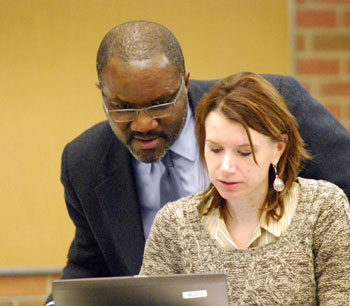
Assistant city attorney Kevin McDonald reviewed the wording of the resolution on the Edwards Brothers property with city clerk Jackie Beaudry.
When councilmembers emerged from the closed session after about a half hour, they voted to go back into open session, and then immediately recessed the meeting so that the verbiage of the resolution could be crafted. [.pdf of amended Edwards Brothers resolution on Jan. 6, 2014]
The resolution directed Ann Arbor city administrator Steve Powers and city attorney Stephen Postema to gather information to help the city council determine whether to purchase the 16.7-acre property on South State Street. The resolution provides direction to explore options to make the purchase financially feasible. That means finding a way to finance a $12.8 million deal.
Some brief back-and-forth resulted in the addition of a deadline for assembling the information: Jan. 30, 2014. Last year there had been some disagreement about when the clock had started ticking on the 60-business-day window for the city to exercise its right of first refusal. In response to an emailed query after the meeting, city administrator Steve Powers stated:
The City is operating on a timeline to provide notice to Edwards Brothers prior to February 25, 2014. This calculation is made from Nov. 27th, 2013.
On returning from recess about 15 minutes later, the council reopened the agenda to add the resolution on the Edwards Brothers property.
Mayor John Hieftje recited a standard explanation of the city’s interest in preserving the city’s tax base. He called the acquisition of the old Pfizer property and the property along South Division where the Blimpy Burger’s previously stood part of a pattern that the University of Michigan has displayed.
Jane Lumm (Ward 2) said she was glad additional information was being gathered so the council could decide whether to exercise its right of first refusal. She said it would be invaluable to have that information so that the council can make its decision. Staff would be looking at the zoning questions, she said, which will help to inform the council’s decision. The site, at 16.7 acres, is the largest remaining such parcel in the city, she said.
Christopher Taylor (Ward 3) echoed Hieftje and Lumm. The University of Michigan’s acquisition of property is a long-term challenge the city faces, he said.
Outcome: The council unanimously approved the resolution directing the city administrator and city attorney to gather information on exercising the city’s right of first refusal on the Edwards Brothers property.
Snowstorm
At the start of the meeting, much of the city administrator’s communications and the public commentary dealt with the snowstorm that began Jan. 4, which ultimately dropped 10.4 inches of snow on the city and subsequently pushed temperatures to -14 F.
Snowstorm: City’s Response
City administrator Steve Powers introduced Craig Hupy, public services area administrator, to give an update on the city’s snow removal response during and after the recent snowstorm.
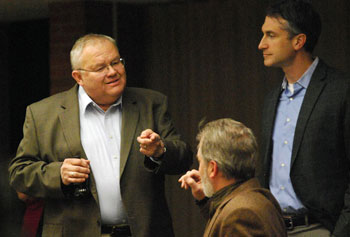
From left: Public services area administrator Craig Hupy, Stephen Kunselman (Ward 3) and Christopher Taylor (Ward 3).
The official tally for snowfall was 10.4 inches. Hupy described how the city had been using 12-hour shifts since New Year’s Eve, and was starting its seventh day of continuous plowing. Hupy said the colder weather was starting to affect the equipment and they were experiencing some breakdowns. He also described how the ridge that the plows were leaving behind on their first pass as the temperatures dropped was pretty stiff, which meant that sometimes motorists who tried to drive through it were getting hung up on that ridge. And that delayed the ability of the plows to make a second pass, he said.
Twenty-four snowplows were working on the local streets right then, and four plows were working major streets to keep drifts back, he said. Hupy also gave a summary of the mileage driven by the city’s snowplows.
Based on data provided to The Chronicle before the meeting, from midnight Sunday through around 1 p.m. Monday, Ann Arbor city snowplows logged 7,641 vehicle miles. Eleven of the city’s fleet logged at least 300 miles during that period. Top mileage for any plow, logged by vehicle number 4551, was 483.9 miles. [.jpg of snowplow mileage chart]
Next to be introduced was Mary Jo Callan, Washtenaw County’s director of the office of community and economic development. Her email message to councilmembers from earlier in the day had by that time been attached to the council’s online agenda. [Callan's Jan. 6, 2014 email] She gave the council a status update. That included reading aloud a portion of her written update:
All community shelters are open, including: the Delonis Center, IHN/Alpha House, Salvation Army’s Staples Center, and Ozone House. Housing Access is also open, and able to connect those in need with shelter options.
Callan said the Delonis Center had opened its daytime warming center, and 25 people were using it. The warming center has a capacity of 200, she said. No one had been turned out into the cold up to that point, she said. The restriction on intoxication in order to gain admittance to the warming center had been loosened, she noted. If someone arrives who is intoxicated to the point of being dangerous or severely disruptive to other guests, they are provided transportation to the Home of New Vision’s Engagement Center.
Callan continued by describing how known campsites had been visited by PORT (the county’s project outreach team). The soundness of tent structures was assessed. Various materials were distributed, she said. The work by PORT had begun on Friday before the storm in anticipation of the storm, she said, and that outreach had continued. Callan reported that 15 people had been put into hotels, extended at least until Friday, Jan. 10.
Callan described a number of warm places, not necessarily warming centers, that were accessible in the urban core area from Ann Arbor to Ypsilanti and in between. As examples, Callan listed off the Delonis Center, Ann Arbor city hall, all Ann Arbor District Library locations, the Ann Arbor Area Transportation Authority, Homeward Bound, University of Michigan Medical Center, and IHN Alpha House.
Callan then read aloud a statement from St. Joe’s, which has space for 30 people. St. Joe’s is looking to coordinate with the county and city on this. The county’s community support and treatment services (CSTS) and Alpha House are coordinating to staff that possible St. Joe’s facility, she said, if a decision is made to use it. That decision would be made later that night, she added.
Mayor John Hieftje got clarification from Callan on the situation with the daytime warming center at Delonis – a capacity of 200, with about 25 people making use of it.
Jack Eaton (Ward 4) asked a question about how much money this is costing all the organizations. He wanted information about how much it is costing so that the city could understand what it might do to help.
Responding to a question from Margie Teall (Ward 4), Callan thanked the council for its recent support of affordable housing. She mentioned the plan that the Ann Arbor housing commission (AAHC) has for Miller Manor to convert it to a front-desk staffed facility. She said the world had changed a lot since the 2007 needs assessment was done. So she’d be providing fresh information soon about what the current needs actually are.
Chuck Warpehoski (Ward 5) said he was glad that the Delonis Center had loosened its restriction on intoxication. He inquired about those people who have been prohibited from accessing the Delonis Center due to behavioral problems. Callan said that the 15 people that PORT has responded to were in that category.
Sumi Kailasapathy (Ward 1) said that the collection of organizations that have stepped forward seemed ad hoc. She wanted to know if it could be better publicized and systematized. Yes, said Callan. There is a plan in place, but it could be better. In some cases, she said, staff for some facilities couldn’t get into work due to the snow.
Police chief John Seto was then invited to the podium to report out. He said there had been no staff shortages, and the AAPD is “response capable.” He said that the department had not seen increased calls for service. On Saturday, Jan. 4, there had been a water pipe rupture at a large student apartment complex, he said, and the city’s emergency manager Rick Norman had worked with the University of Michigan’s office of the dean of students to place students from that building in temporary housing.
City’s Response to Snowstorm: Public Commentary
During public commentary on a different topic at the start of the meeting, saying that she wanted to start on a positive note, Kathy Griswold reported that her street had been plowed early Monday morning and that when she drove around town, she observed the streets were well-plowed, even the mid-block crosswalks.
Tracy Williams introduced himself as a homeless resident. People are in trouble, he said, and although we can keep talking, we need to be doing. He suggested 721 N. Main as a possible warming shelter. The city’s plan to demolish the building and turn it into a park would prevent that, he noted. Williams said that instead of turning it into a park, the city should turn it into a cemetery – because that way, the city’s homeless might finally find a place to rest there.
Ryan Sample commended the Delonis Center for operating beyond its capacity. He urged the city to open the doors to the 721 N. Main building for use as a warming center.
Tate Williams said that the existing social services network is overtasked and underfunded. It leaves many people unable to receive the help they need to survive, he said. He asked for the city to provide a way for citizens to help in an organized way – including opening their homes to the homeless.
Sheri Wander told the council she lives on White Street. She apologized if her remarks came off as emotional. She’d spent the last several days delivering propane tanks to those who are living in tents. She said she was “in awe” of PORT as they raced around to put some people in hotel rooms. She was proud of what the city had done, but it shouldn’t be done at the last minute, she said. She hears over and over that the city has the infrastructure and the capacity to take care of people. But she didn’t think there’s enough sanctioned capacity to take care of people. “I know the city can do better,” she said. Wander wanted the city to look at 721 N. Main, even though that facility isn’t perfect, she said. She quoted G.K. Chesterton: “Anything worth doing is worth doing badly.”
Greg Pratt thanked all the previous speakers by name. He also thanked Mary Jo Callan. He appreciated all the support. But he offered an alternative pledge of allegiance: “I pledge allegiance to the people of the city of Ann Arbor and to the principle for which we all stand: warming centers open at 45 F degrees, with room for people who blow above .10.” The phrase “for which we all stand” was a cue for the rest of the audience in attendance advocating for the homeless community to stand up, which they did. Pratt concluded his remarks by raising his fist: “Power to the people!”
Odile Hugonot-Haber read aloud Article 25 of the Universal Declaration of Human Rights, which includes the right to housing. She said that city officials seemed to want to say that everything is just fine. She allowed that what the city had done was good, but called for more to be done. The timer ending her speaking time then went off prematurely, and her remarks concluded after about a minute and a half, instead of three minutes.
Alan Haber thanked Odile for reading aloud from the Universal Declaration of Human Rights. Ann Arbor should adopt warmth as a fundamental human right, he said. Warmth is not just temperature, he noted. Statistics might show that everyone is taken care of, he said, but from what he’s heard and seen, that’s not so. The city needs a space that is managed by those who use it, he said. All of us should be more contributory. The homeless “them,” he said, are seen as a problem. But they have creativity and skills. He called on the council to consider 721 N. Main as an option.
City Response to Snowstorm: Council Coda
Jack Eaton (Ward 4) noted that when Camp Take Notice was dispersed, the city had interfered with an attempt to create a self-governed community to deal with homelessness in the way that Haber described. Eaton ventured that the city might lease a city building to a group. His remarks drew applause.
How Much Is a Parking Space Worth?
The council considered a resolution that defines a policy setting the amount that a developer would need to pay, if a project causes an on-street metered parking space to be removed from the system.
The proposed amount in the original resolution was $45,000 per space. The money to be paid would be passed through to the Ann Arbor Downtown Development Authority. The payment goes to the Ann Arbor DDA because the DDA manages the public parking system under a contract with the city.
The resolution had been postponed for the second time at the council’s Dec. 16, 2013 meeting, and that’s why it appeared on the Jan. 6 agenda. The rationale for originally postponing the item on Dec. 2 – offered by Christopher Taylor (Ward 3), who sponsored the resolution – was that because it amounts to a fee, a public hearing should be held on the matter before the council voted.
After the public hearing held at the council’s Dec. 16 meeting, the council’s deliberations focused on the question of the accounting procedures to be used by the DDA in tracking any money that might be paid under the policy.
Given that the rationale for the policy is that the money would be put toward the cost of constructing new parking spaces, councilmembers wanted to know how the money would be reserved for that purpose.
In this matter, the council was acting on a four-year-old recommendation approved by the Ann Arbor DDA in 2009:
Thus it is recommended that when developments lead to the removal of on-street parking meter spaces, a cost of $45,000/parking meter space (with annual CPI increases) be assessed and provided to the DDA to set aside in a special fund that will be used to construct future parking spaces or other means to meet the goals above. [.pdf of meeting minutes with complete text of March 4, 2009 DDA resolution]
The contract under which the DDA manages the public parking system for the city was revised to restructure the financial arrangement (which now pays the city 17% of the gross revenues), but also included a clause meant to prompt the city to act on the on-street space cost recommendation. From the May 2011 parking agreement:
The City shall work collaboratively with the DDA to develop and present for adoption by City Council a City policy regarding the permanent removal of on-street metered parking spaces. The purpose of this policy will be to identify whether a community benefit to the elimination of one or more metered parking spaces specific area(s) of the City exists, and the basis for such a determination. If no community benefit can be identified, it is understood and agreed by the parties that a replacement cost allocation methodology will need to be adopted concurrent with the approval of the City policy; which shall be used to make improvements to the public parking or transportation system.
Subject to administrative approval by the city, the DDA has sole authority to determine the addition or removal of meters, loading zones, or other curbside parking uses.
The $45,000 figure is based on an average construction cost to build a new parking space in a structure, either above ground or below ground – as estimated in 2009. [For more background, see: "Column: Ann Arbor's Monroe (Street) Doctrine."]
Taylor, the resolution’s sponsor, participated in meetings during the fall of 2013 of a joint council and DDA board committee that negotiated a resolution to the question about how the DDA’s TIF (tax increment finance) revenue is regulated. In that context, Taylor had argued adamantly that any cap on the DDA’s TIF should be escalated by a construction industry CPI, or roughly 5%. Taylor’s reasoning was that the DDA’s mission is to undertake capital projects and therefore should have revenue that escalates in accordance with increases in the costs to undertake capital projects.
Based on Taylor’s reasoning on the TIF question, and the explicit 2009 recommendation by the DDA to increase the estimated $45,000 figure in that year by an inflationary index, the recommended amount now, four years later, would be closer to $55,000, assuming a 5% figure for construction cost inflation. The city’s contribution in lieu (CIL) parking program allows a developer (as one option) to satisfy an on-site parking space requirement by paying $55,000. (The other option is to enter into a 15-year agreement to purchase monthly parking permits at a 20% premium.)
The actual cost of building an underground space in the recently completed (2012) underground Library Lane parking structure could be calculated by taking the actual costs and dividing by 738 – the number of spaces in the structure. Based on a recent memo from executive director Susan Pollay to city administrator Steve Powers, about 30% or $15 million of the cost of the project was spent on items “unneeded by the parking structure.” That included elements like oversized foundations to support future development, an extra-large transformer, a new alley between Library Lane and S. Fifth Avenue, new water mains, easements for a fire hydrant and pedestrian improvements.
The actual amount spent on the Library Lane structure, according to DDA records produced under a Freedom of Information Act request from The Chronicle, was $54,855,780.07, or about $1.5 million under the project’s $56.4 million budget. Adjusting for those elements not needed for the parking structure yields a per-space cost of about $52,000. [(54,855,780.07*.70)/738] [.pdf of Nov. 22, 2013 memo from Pollay to Powers][.pdf of budget versus actual expenses for the 738-space Library Lane structure]
By way of additional background, the Ann Arbor DDA’s most recent financial records show that last year, on-street parking spaces generated $2,000 in gross revenue per space or $1,347 in net income per space annually. The contract with the city under which the DDA operates the public parking system stipulates that the city receives 17% of the gross parking revenues. So the city’s revenue associated with an on-street parking space corresponds to $340 annually.
Based on information provided to the council by the DDA, the majority of on-street spaces that have been removed from the system since 2006 can be attributed to University of Michigan projects.
How Much Is a Parking Structure Worth: Council Deliberations
Christopher Taylor (Ward 3) described the resolution, noting that it creates a policy that the contract between the city and the DDA describes.
Sally Petersen (Ward 2) wanted to amend the resolution. She said that the true cost of a metered parking space should include the net present value estimate for the revenue associated with a parking space. She’d chosen a 10-year projection provided by the staff. She and Taylor had had some back-and-forth on the amendment, she reported. Her amendment ensured that the city would get 17% of the revenue from that portion of the payment that compensates for lost revenue.
Sumi Kailasapathy (Ward 1) wanted to amend the resolution so that the money that goes to the DDA is recorded as restricted funds for capital projects in the parking system.
Taylor responded, saying that they were both excellent ideas, which he was happy to support. The changes were considered “friendly.” [At its Dec. 18, 2013 meeting, the DDA operations committee discussed the matter and concluded that the money paid under the meter-removal policy would be shown as a restricted amount in the DDA’s parking maintenance fund.]
Taylor also offered an amendment of his own: swapping out the phrase “on the parcels” for “in the right of way.” That amendment was accepted as “friendly” as well.
Jane Lumm (Ward 2) said the changes were an improvement. She thanked staff. She supported the resolution. Lumm reviewed how many meters had been removed in the past. She thought it was important to adopt a requirement for reimbursement for lost revenue, because the amounts that accumulate can be substantial.
By way of more detailed background, the policy applies in part only if the DDA were to determine that the removal of a parking space is not a community benefit, but rather is localized to a particular development. Subsequent council deliberations focused on a part of the policy that provides for a review of the decision by the city administrator: “The City Administrator shall review the DDA’s determination of whether space removal would constitute a community benefit, and is authorized to reverse such determination if, in the City Administrator’s reasonable discretion, the DDA has incorrectly evaluated the existence of ‘community benefit.’”
At the Jan. 6 meeting, Jack Eaton (Ward 4) raised the question about the authorization of the city administrator to review the DDA decision. Given that the city administrator now sits on the DDA board, Eaton wanted to substitute “city council” as the party responsible for the review.
Margie Teall (Ward 4) said she understood the conflict that was being pointed out. But she didn’t think the council should review the decision. She felt it could be handled within the administration. Stephen Kunselman (Ward 3) said he didn’t have a problem with the city administrator having the authority to override the DDA as a whole.
City administrator Steve Powers stated that he felt he could balance the responsibility, noting that his ultimate accountability is to the city council.
Eaton noted that he was not questioning the ability of Powers to balance the decision, but thought it was bad public policy to have someone sitting on a board who then reviews the decisions of that same board.
Mayor John Hieftje responded by saying that the DDA statute requires conflict in some ways. Petersen noted that the DDA has not drafted a policy for evaluating public benefit.
Kailasapathy characterized the issue as one of checks and balances, and not the integrity of Powers. We’re human beings and we’re fallible, she said. Having the same person implementing the policy and reviewing it isn’t good policy, she said.
Kunselman indicated agreement that it might not be good policy, but noted that government is messy. If the city council should review the decision, as Eaton was suggesting, he wondered if the council shouldn’t just take back the whole parking system. He didn’t think it’s possible to avoid the kind of conflict that Eaton had identified. The language is fine the way it is, Kunselman said.
Lumm said she appreciated Kunselman’s remarks. Having someone else besides Powers in the administration review the decision would still mean that person would be reporting to Powers, she noted. And to drag the city council into it, she said, wouldn’t be a good idea. She ventured that the council might want to weigh in on the drafting of the public benefit policy.
Eaton said it’s purely a process question, and it’s not a desire for the city council to take over that role – but he doesn’t know who else would take that role.
Petersen said that it’d been a good discussion and it showed that the council needs training on what is and isn’t a conflict of interest. [Petersen was alluding to a resolution that she'd put forward, which the council passed at its Nov. 18, 2013 meeting, calling for the development of an ethics education program.] She compared it to having a separate person collect the money and count the money. She was willing to let the issue go forward with the city administrator being the reviewer.
Outcome on Eaton’s amendment: Only Kailasapathy and Eaton vote for the amendment, so it failed.
Outcome on main resolution: The council voted unanimously to approve the policy, as amended, for charging a fee of $45,000 for removal of an on-street parking space, plus payment of 10-years worth of projected revenues generated by the space.
Killing Fuller Road Station MOU
The council considered a resolution that terminates a four-year-old memorandum of understanding between the city of Ann Arbor and the University of Michigan on Fuller Road Station.
Fuller Road Station was a planned joint city/UM parking structure, bus depot and possible train station located at the city’s Fuller Park near the UM medical campus. The council had approved the MOU on the Fuller Road Station project at its Nov. 5, 2009 meeting on a unanimous vote. [.pdf of Nov. 5, 2009 MOU text as approved by the city council] However, a withdrawal of UM from the project, which took place under terms of the MOU, was announced on Feb. 10, 2012. So it’s been clear for nearly two years that the MOU was a dead letter.
The item had been postponed from the council’s Dec. 16, 2013 meeting. Stephen Kunselman (Ward 3) sponsored that Dec. 16 resolution. The idea to terminate the MOU has its origins in election campaign rhetoric. He had stated at a June 8, 2013 Democratic primary candidate forum that he intended to bring forth such a resolution to “kill” the Fuller Road Station project. From The Chronicle’s report of that forum:
Kunselman also stated that he would be proposing that the city council rescind its memorandum of understanding with the University of Michigan to build a parking structure as part of the Fuller Road Station project. Although UM has withdrawn from participation in that project under the MOU, Kunselman said he wanted to “kill it.” That way, he said, the conversation could turn away from using the designated parkland at the Fuller Road Station site as a new train station, and could instead be focused on the site across the tracks from the existing Amtrak station.
The city continues to pursue the possibility of a newly built or reconstructed train station, but not necessarily with the University of Michigan’s participation, and without a pre-determined preferred alternative for the site of a new station. At its Oct. 21, 2013 meeting, the council approved a contract with URS Corp. Inc. to carry out an environmental review of a project called the Ann Arbor Station. That review should yield the determination of a locally-preferred alternative for a site.
At the Dec. 16 meeting, Kunselman led off deliberations by saying he wanted to postpone the resolution. He indicated that he thought he’d managed to add the item to the agenda on the Friday before the Monday meeting, but it turned out he had not done so. In light of the council’s discussion at their Dec. 9 budget planning session – when councilmembers had said they’d strive to avoid adding resolutions at the last minute – Kunselman said he wanted it postponed.
On Dec. 16, mayor John Hieftje and Sabra Briere (Ward 1) both indicated they’d vote for the resolution – but also said they didn’t think the resolution was necessary. They indicated they were willing to vote for the resolution without postponing. Kunselman nevertheless wanted to postpone it, because it was added late to the agenda. That’s why it appeared on the Jan. 6 agenda.
Killing Fuller Road MOU: Public Commentary
During public commentary at the start of the meeting, Kathy Griswold said she supported the termination of the Fuller Road Station memorandum of understanding. She called on the council to pay attention to process.
Road Station MOU: Council Deliberations
At the Jan. 6 meeting, Kunselman introduced the resolution. He called it wrapping up loose ends on a document that doesn’t have an expiration date. Hieftje said it’s like digging someone up who died a couple of years ago and re-burying them, but he was not opposed to that.
Outcome: The council voted to terminate the Fuller Road Station MOU.
Traverwood Apartments
The council considered two questions related to a First Martin Corp. project, which would construct a residential complex on the city’s north side. The project – located on the west side of Traverwood Drive, north of Plymouth Road – is called Traverwood Apartments.
The project, estimated to cost $30 million, would include 16 two-story buildings for a total of 216 one- and two-bedroom units – or 280 total bedrooms. Eight of the buildings would each have 15 units and 11 single-car garages. An additional eight buildings would each have 12 units and 8 single-car garages.
Two separate items were on the council’s agenda – one for the rezoning required for the project, and the other for the site plan and wetland use permit.
At the council’s Dec. 2, 2013 meeting, the initial approval of the required rezoning was given. Also approved at that meeting was a donation of 2.2 acres, just north of the project site – by Bill Martin, founder of First Martin Corp., to the city. The donated acreage is next to the Stapp Nature Area and the Leslie Park golf course.
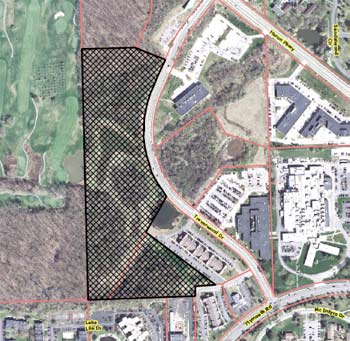
Aerial view of the site for the proposed Traverwood Apartments at 2225 Traverwood Drive, north of Plymouth Road.
The city’s planning commission recommended approval of the site plan and the required rezoning at its Nov. 6, 2013 meeting. The site is made up of two parcels: a nearly 16-acre lot that’s zoned R4D (multi-family residential), and an adjacent 3.88-acre lot to the south that’s currently zoned ORL (office, research and light industrial). It’s the smaller lot that needed to be rezoned R4D.
Traverwood Apartments: Public Hearing
During the public hearing on the rezoning aspect of the proposal, Mike Martin of First Martin told the council that the project team was in attendance and available to answer questions.
Thomas Partridge gave general commentary critical of the rezoning proposal. He wanted the proposal postponed until there is a requirement in every such proposal that ensures the turnaround of egregious past discrimination.

During a recess, Peggy Rabhi showed Earl Ophoff of Midwestern Consulting what her concerns were about the Traverwood Apartments project.
During the public hearing on the Traverwood Apartments site plan, Partridge followed up on his earlier remarks, by saying that it amounts to egregious discrimination to not take up the question of whether a site was used for the Underground Railroad, before approving the site plan.
Peggy Rabhi posed questions about the wetland use permit. She said it looked like the project will preserve the “lake” and the largest pond on the south end of the property. The south pond is home to frogs, newts and salamanders, she said. Those species pass the winter not in the pond, but rather adjacent to the pond, she said. She hoped that First Martin would be willing to work with the city’s natural area preservation staff on this issue.
Stacie Printon told the council she’s a park steward for the park adjacent to the property. She expressed some concerns and made some suggestions. The southwest portion of the plan abuts Leslie Park golf course and Leslie Woods, so she had concerns about the impact on those woods. There will be some cutting into the slopes, she said. There are three trees worthy of preservation, numbered 2582, 2583, and 2584. Buildings #5 and #6 come very close to the corner, she said. She suggested combining the buildings into a single L-shaped building that might eliminate the need for a retaining wall.
Traverwood Apartments: Council Deliberations
Jane Lumm (Ward 2) led things off, saying that she’d seen the development team having a conversation with those who spoke during the public hearing.
She asked for some response to the concerns described during the public commentary. Earl Ophoff of Midwestern Consulting responded by offering a description of the retaining walls – which are tiered so that the impact on the critical root zones of nearby trees is minimized.

During a recess, the Traverwood Apartments development team discussed aspects of the project with member of the public who spoke during the public hearing.
The location of the building that had been mentioned was predicated on the 22-foot deep sanitary sewer, he said, which had public easement associated with it. So it couldn’t be moved or twisted as had been suggested. The entire hedgerow along the south and the west had been preserved, he noted.
Ophoff described how the timing of the construction was key to various considerations. One was the interest in protecting the Indiana bat habitat at the north end of the site where there are shagbark hickories. To the extent that trees needed to be removed, he said, they wanted to do that when any bats that might live there during the warmer months were not there. So that tree removal needed to begin as soon as possible, now during the winter months, he explained.
Ophoff then described how the newts and salamanders will be finishing their mating in the spring around March and May before the project starts work. Right now they’re hibernating in the sedimentation basin in the mud.
Jack Eaton (Ward 4) asked about a pipe to be installed in connection with the wetland. Wetland #2 has three parts, Ophoff explained – a natural pond, a ditch, and a detention basin. The ditch will be enclosed in a pipe, so that driveway connections can be established. That 1,800 square feet is mitigated with about 2,700 square feet. Eaton was concerned that the pipe was undersized – because it could only handle a 10-year storm. Ophoff said that such pipes are not generally designed to accommodate a 100-year rain. If there were a 100-year rain, there would be standing water in a lot of places, he said.
Responding to Eaton’s concern, Ophoff noted that the ditch is not a creek, and normally there’s no water flow there.
Outcome: The council voted to approve the site plan and wetland use permit for the Traverwood Apartments project. In a separate vote, taken before the site plan and wetland use permit vote, the council approved without discussion the required rezoning.
Montgomery Ward Building
The council considered the site plan for a four-story addition to the existing two-story building at 210-216 S. Fourth Ave., between East Liberty and East Washington in downtown Ann Arbor. The plan calls for creating 32 new housing units, including four studios, 14 one-bedroom, and 14 two-bedroom units. Planning commissioners recommended approval of the project’s site plan at their Nov. 19, 2013 meeting.
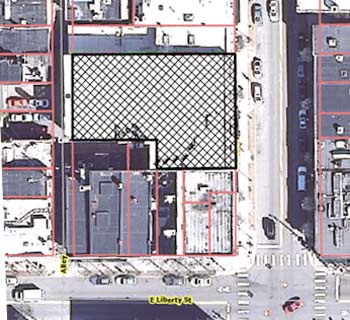
Aerial view of the Montgomery building (indicated with crosshatches) at 210 S. Fourth Ave. in downtown Ann Arbor.
The estimated $3.8 million project would expand the existing 17,273-square-foot building – a former Montgomery Ward’s department store – to 38,373 square feet, with housing on the second through fifth floors. The ground floor would remain commercial space. Current tenants include Salon Vertigo and Bandito’s Mexican Restaurant. The top floor will include a stair/elevator lobby, restroom, wet bar, and access to several roof decks. Part of the fifth-floor roof will be covered in vegetation as a green roof.
Because the building is located in a historic district, it required a certificate of appropriateness from the city’s historic district commission. The HDC granted that certificate at its Sept. 12, 2013 meeting.
The site is zoned D1, which allows for the highest level of density. According to a staff memo, eight footing drain disconnects will be required.
According to a report from the July 10, 2013 citizen participation meeting, the units will be marketed to “anyone who wants to live downtown.” If approvals are received, construction is expected to begin next summer. The project’s architect is Brad Moore.
Moore is also the architect for an expansion project on the adjacent property – a three-floor addition to the Running Fit building at East Liberty and South Fourth, which will create six residential units. That project received a recommendation of approval from planning commissioners at their Oct. 15, 2013 meeting and was subsequently approved by the city council on Dec. 2, 2013.
During the public hearing, architect Brad Moore described the project as next to the Running Fit building, which the council had recently approved. He described the basic highlights of the project. Also during the public hearing Thomas Partridge said the attempt to rehabilitate the property is admirable. But he’d not heard the two words he thought were essential: “Affordable housing.”
Outcome: The council voted without discussion to approve the site plan for the old Montgomery Ward building.
Briarwood Mall Restaurant Expansions
The council considered the site plan for construction of two freestanding restaurants at Briarwood Mall.

Aerial view of Briarwood Mall. The cross-hatched section indicates the parcel where two new restaurants are proposed, adjacent to Macy’s.
The proposal calls for building two new restaurants – one at 6,470 square feet, the other at 7,068 square feet – on the east side of the Macy’s building at Briarwood Mall, 700 Briarwood Circle. The restaurants would be two chains: P.F. Chang’s and Bravo! Cucina Italiana.
The parking lot north and east of the new restaurants would be reconfigured, reducing the total amount of parking by 188 spaces. The estimated cost of the project is $1,577,094. The site is located in Ward 4.
Ann Arbor planning commissioners recommended approval of the site plan and development agreement in action at their Nov. 19, 2013 meeting. The project was originally considered at the commission’s Oct. 15, 2013 meeting, but postponed because of outstanding issues.
Originally, the planning staff had indicated that the project would require rezoning a portion of the parking lot from P (parking) to C2B (business service. However, according to a memo accompanying the commission’s Nov. 19 meeting packet, planning staff subsequently determined that because the original 1973 Briarwood Mall zoning anticipated the expansion of Hudson’s (now Macy’s ) to the east, no rezoning was needed.
During the council’s Jan. 6 public hearing on the Briarwood Mall site plan, Thomas Partridge told the council he was a recent candidate for the city council as well as for the Michigan state house and senate. He’d attended meetings of several different public bodies over the last decade. He reiterated his standard call for a requirement that all site plans include provisions for access to public transportation and affordable housing.
Outcome: The council voted without discussion to approve the Briarwood Mall restaurant expansion site plan.
Cellular Antenna Licensing
As a part of its consent agenda, the council considered two items involving cellular phone antennas mounted on city facilities. By council rule, contracts for less than $100,000 can be placed on the consent agenda.

Antennas from left: Plymouth Road water tower, Ann-Ashley parking structure, Manchester Road water tower.
One of the consent agenda items related to the specific contracts with Sprint for placing antennas at four facilities: the Plymouth Road water tower, the Manchester Road water tower, the Ann-Ashley parking structure, and the water treatment plant on Sunset Road. The contracts are being revised upwards to $45,000 a year at each location with 4% annual escalators. The previous agreements ranged from $25,920 to $39,283, according to the staff memo accompanying the resolution.
Total revenue to the city for cell antennas budgeted for FY 2014 is $520,000, all of which goes towards debt service on the Justice Center.
The staff memo also indicated that Sprint has been given initial administrative approval to undertake replacement of some of its equipment related to its 4G deployment.
The other consent agenda item related to cellular phone antennas made it unnecessary in the future for items like the agreements with Sprint to come before the city council for approval. Instead, the city administrator was given the power to approve licensing agreements with cellular service providers – even though they exceed the $25,000 threshold for council approval set forth in a city-charter required ordinance.
Outcome: The council approved the consent agenda, including the cellular antenna items.
Ann Arbor Summer Festival Board
The council considered a resolution appointing directors to the board of the nonprofit Ann Arbor Summer Festival. It reflected a certain amount of bureaucratic housecleaning, as all of the appointments were retroactive, some of them dramatically so:
- Oct. 1, 2011 to Sept. 30, 2014 Paul Cousins (trustee, Dexter Village)
- Oct. 1, 2011 to Sept. 30, 2014 Erica Fitzgerald (attorney with Barris, Sott, Denn & Driker)
- Oct. 1, 2011 to Sept. 30, 2014 Linda Girard (CEO, Pure Visibility)
- Oct. 1, 2011 to Sept. 30, 2014 Kimberly Scott (attorney with Miller Canfield)
- Oct. 1, 2011 to Sept. 30, 2014 Ellie Serras (community relations director, Main Street BIZ)
- Oct. 1, 2011 to Sept. 30, 2014 Christie Wong Barrett (manufacturing council at U.S. Department of Commerce)
- Oct. 1, 2012 to Sept. 30, 2015 Tim Freeth (head of industry, Google)
- Oct. 1, 2012 to Sept. 30, 2015 Jerold Lax (attorney with Pear Sperling Eggan and Daniels)
- Oct. 1, 2012 to Sept. 30, 2015 Kenneth Magee (former head of University of Michigan public safety)
- Oct. 1, 2012 to Sept. 30, 2015 Kevin McDonald (city of Ann Arbor, assistant city attorney)
- Oct. 1, 2013 to Sept. 30, 2016 Tom Crawford (city of Ann Arbor, chief financial officer)
- Oct. 1, 2013 to Sept. 30, 2016 Mary Kerr (president, Ann Arbor Area Convention & Visitors Bureau)
- Oct. 1, 2013 to Sept. 30, 2016 Dug Song (CEO of Duo Security, tech entrepreneur)
Most of these members, however, do not appear to meet the membership criteria listed out in the description available on the city’s online Legistar system, which reads:
Membership/Committee Composition: Representatives from each of the following: Ann Arbor Street Art Fair, South University Merchants Association, State Street Area Art Fair, State Street Area Association, Michigan Guild of Artists and Artisans, Main Street Area Association, Washtenaw Non-Profits, Ann Arbor Transportation Authority, Ann Arbor Area Convention and Visitors Bureau, Ann Arbor City Council (2-1 each caucus), City and County Government Departments (4 votes total): Ann Arbor Building Dept., Ann Arbor Police Dept., Ann Arbor Fire Dept., Ann Arbor Solid Waste Dept., Ann Arbor Transportation Division, Ann Arbor Attorney’s Office, Washtenaw County Health Dept., U of M (2 votes total): Community Relations, Public Safety, Michigan Union, Plant Operations, Parking Services.
Mayor John Hieftje, who sponsored the resolution, did not respond before the council meeting to an emailed Chronicle query about the issue, but spoke to The Chronicle after the meeting. He said it wasn’t clear from what document the Legistar description originated, but that it would be removed from the online description.
Some confusion surrounding these appointments is reflected in one of the resolved clauses of the resolution, which reads:
RESOLVED, That the Mayor and City Council request that the Ann Arbor Summer Festival, Inc., clarify the designation process in their Bylaws and implement an annual designation process by August 1, 2014.
The Ann Arbor Summer Festival runs for about three weeks each year and includes indoor ticketed performances and free outdoor events at the Top of the Park. Revenues come from ticket sales, sponsorships and donations.
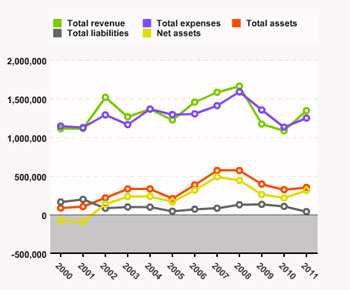
Ann Arbor Summer Festival financial data from 2000-2011 from the National Center for Charitable Statistics. http://nccsweb.urban.org/
Hieftje told the council that the resolution had been prompted by a bylaws review of the Ann Arbor Summer Festival board. He then praised the Summer Festival for its work.
Outcome: The council voted to approve the board appointments to the Ann Arbor Summer Festival.
Nominations to Pedestrian Safety Task Force
Nominations were made at the Jan. 6 meeting for the nine members of the pedestrian safety task force, which was established by the council at its Nov. 18, 2013 meeting. The nominations are: Vivienne Armentrout, Neal Elyakin, Linda Diane Feldt, Jim Rees, Anthony Pinnell, Sarah Pressprich Gryniewicz, Kenneth Clark, Scott Campbell, and Owen Jansson. The council will vote on their confirmations at its Jan. 21 meeting.
Related to that, the first part of the non-motorized transportation plan implementation strategy that the city administrator was directed by the city council to develop had also been released by the time of the Jan. 6 meeting. This was the part of the council’s direction that dealt with improvement of traffic enforcement at and around crosswalks. [.pdf of crosswalk traffic enforcement plan implementation strategy]
Highlights of that strategy include targeted enforcement that was to take place on Jan. 9 and Jan. 10 using council-authorized police overtime pay for that purpose. The police department has also developed an online tool for reporting traffic complaints and concerns.
Communications and Comment
Every city council agenda contains multiple slots for city councilmembers and the city administrator to give updates or make announcements about important issues that are coming before the city council. And every meeting typically includes public commentary on subjects not necessarily on the agenda.
Comm/Comm: New Year’s Events
At the end of the meeting, during council communications time, Margie Teall (Ward 4) thanked police chief John Seto and the staff for their work on the New Year’s Eve celebration activities on Main Street, called The Puck Drops Here. She hoped it would be repeated.
Comm/Comm: Dream Nite Club
City attorney Stephen Postema reported to the council that the Michigan Court of Appeals had upheld the city’s position in the revoking the Dream Nite Club’s liquor license. Postema thanked the police department for its role in that.
Comm/Comm: Thomas Partridge
During public commentary at the start of the meeting, Thomas Partridge called on the council to protect the most vulnerable. He criticized various “right wing proposals.” He wanted provisions in all site plan approvals requiring accessibility for public transportation and affordable housing.
Partridge also addressed the council at the conclusion of the meeting during public commentary general time. He allowed that people might question why he attends council meetings calling on the council to abide by the law and the constitution. He called for reform and a turnaround of the council. He called again, as he has before, for the resignation of mayor John Hieftje and Michigan Gov. Rick Snyder. He alleged that he’s had property stolen and has been subject to threats of intimidation. Huge amounts of snow have been piled up around buildings that house handicapped people, he claimed.
Present: Jane Lumm, Margie Teall, Sumi Kailasapathy, Sally Petersen, Stephen Kunselman, Marcia Higgins Jack Eaton, John Hieftje, Christopher Taylor, Chuck Warpehoski.
Absent: Sabra Briere, Mike Anglin.
Next council meeting: Jan. 21, 2014 at 7 p.m. in the council chambers at city hall, located at 301 E. Huron. [Check Chronicle event listings to confirm date]
The Chronicle could not survive without regular voluntary subscriptions to support our coverage of public bodies like the Ann Arbor city council. We sit on the hard bench so that you don’t have to. Click this link for details: Subscribe to The Chronicle. And if you’re already supporting us, please encourage your friends, neighbors and colleagues to help support The Chronicle, too!





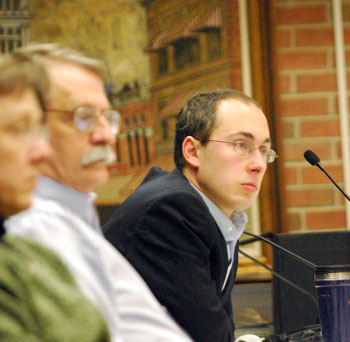

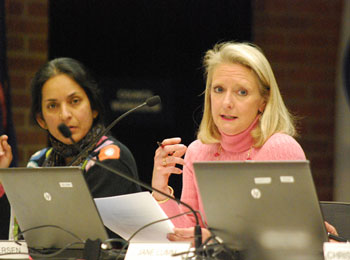
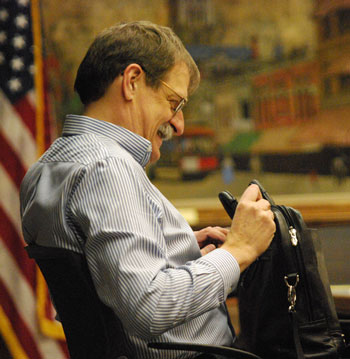
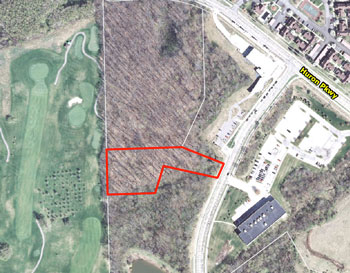
Clarification with regard to Camp Take Notice: I assume that Jack Eaton was speaking loosely in referring to the city’s role in dismantling it. The location of CTN on the west side of Wagner Road near Elizabeth was not in the City of Ann Arbor. I’ve been reviewing news stories and those and my informally received information indicated that highway patrolmen dismantled it under direction from MDOT, on whose property it was, and with impetus from Governor Rick Snyder. Snyder, I have been told, was distressed that Ann Arbor was featured in a national television show (Tavis Smiley) with a discussion of Camp Take Notice. A video of that segment is here: [link] In any event, it was not “the city” that dismantled it.
Re Dream-Nite-Club:
On December 3.2013, a three-judge panel heard oral arguments in the appeal. Several members of the AAPD appeared as well as a number of Dream-Nite supporters and Steve Postema delivered oral argument on behalf of the City of Ann Arbor and Roger Farinha on behalf of the night club.
While the AAPD may be celebrating this one – the case that City Attorney Postema is still defending is the Dr. Catherine Wilkerson case against AAPD officer Kevin Warner. On Oct. 31 the 6th Circuit U.S. Court of Appeals in Cincinnati reversed a judgment in favor of Warner and remanded the case for trial in U.S. District Court in Detroit; the appeals panel held fact issues existed as to whether Warner violated Dr. Wilkerson’s 4th Amendment rights against unreasonable force and reinstated also her common-law state assault and battery claims. The Washtenaw Watchdogs at washtenawwatchdogs.com covered the recent events in that case.
The City Attorney never makes a public report to City Council of court defeats like the recent Dr. Wilkerson reversal. Only when he wins.
Um, Marcia Higgins was present at this meeting? Kind of amusing since the slamfest against her in the primary was that she wasn’t there.
Re: [3] I’ve corrected the attendance record for this meeting and updated the boilerplate meeting file with the current list of councilmembers.
Wow, that Washtenaw Watchdogs (=Doug Smith) site is quite a thing. Thanks for bringing it to my attention, Mark.
@Rod Johnson:
The Washtenaw Watchdogs was founded by a former U-M Medical School professor and pathologist(Doug Smith).
They employ legal methods such as the Freedom of Information Act to pry loose evidence of breaches of the public trust in local government. Their favorite targets are the University of Michigan and the law enforcement community.
I know who Doug Smith is, Mark (I even noted him in my comment), and I’m familiar with his brief, unhappy time at UM and his subsequent exploits. I simply was unaware of the Washtenaw Watchdogs site.